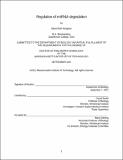Regulation of miRNA degradation
Author(s)
Kingston, Elena Ruth
DownloadThesis PDF (13.55Mb)
Advisor
Bartel, David
Terms of use
Metadata
Show full item recordAbstract
miRNAs are small RNAs that repress gene expression by guiding the effector protein Argonaute (Ago) to complementary sites in the 3′ UTRs of target genes. The levels of a miRNA in a given cell-type are determined by the balance of its rates of production and decay. Although much is known about miRNA production, relatively little is understood about miRNA degradation. Here, I describe the work that I’ve done to address this gap in our knowledge.
To understand the extent that degradation rate is individually specified for miRNAs, I measured miRNA dynamics in mammalian cells. Supporting individualized regulation, measured miRNA half-lives spanned two orders of magnitude. Analyses of these data suggested that interactions with targets help shape turnover rates, and indeed, we showed that target RNA-directed miRNA degradation (TDMD) – a phenomenon whereby a highly complementary target site promotes degradation of the bound miRNA – is largely responsible for driving rapid turnover of miR-7. This observation raises the possibility that TDMD might also destabilize other miRNAs.
The subsequent discovery that the protein ZSWIM8 mediates TDMD, and the identification of many miRNAs that are stabilized upon loss of ZSWIM8, confirmed that this pathway broadly shapes miRNA turnover dynamics. We investigated whether other classes of small RNAs might too be regulated by this pathway, and found that loss of the Drosophila ZSWIM8 homolog, Dora, has no discernible effect on the levels of small-interfering RNAs (siRNAs). Such protection from regulation by Dora is conferred by the Ago protein into which siRNAs load. This finding implies that effector protein identity dictates whether a small RNA is regulated by ZSWIM8.
Loss of Dora is lethal, suggesting an essential role for TDMD during development, yet this lethality precludes the rigorous analysis of dora animals. To circumvent this challenge we disrupted TDMD in a more targeted manner by identifying and perturbing a TDMD-triggering, highly complementary target site for a single miRNA in flies. Although analyses of this fly line reveal some ways in which TDMD shapes organismal development, future studies are needed to fully understand the how the regulation of miRNA degradation operates throughout the Drosophila lifecycle.
Date issued
2021-09Department
Massachusetts Institute of Technology. Department of BiologyPublisher
Massachusetts Institute of Technology